A signature achievement
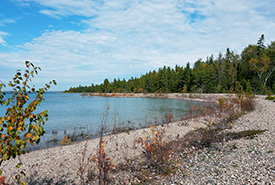
Cockburn Island shoreline (Photo by Mike Lamont)
By Brian Banks, award-winning writer and journalist
The Nature Conservancy of Canada’s Landmark Campaign has led to a 115,000-square-kilometre expansion of protected lands and waters, made possible by donations from 110,000 Canadians from all regions and walks of life.
Cockburn Island may be the seventhlargest island in the Great Lakes, but it’s not exactly a household name. In conservation circles, however, it’s on everyone’s radar. Located in northern Lake Huron, west of Manitoulin Island, the 17,000-hectare (42,000-acre) island is home to one of the largest intact hardwood forest and coastal ecosystems in southern Ontario. It provides habitat for many globally significant plants and animals and is an important stopover site and breeding area for migratory songbirds and waterfowl.
That’s why, for nearly a decade, and with the support of thousands of donors, the Nature Conservancy of Canada (NCC) has led an international effort to protect it. That work began in 2012 and, since 2013, continued as a signature embodiment of the vision of NCC’s national Landmark Campaign — a just-concluded eight-year drive that raised in excess of the campaign’s goal of $750 million for conservation, thanks to 1.1 million donations. This led to the expansion of NCC’s network of protected lands and waters by a record-breaking 115,000 square kilometres. There’s no question; the campaign has been a resounding success.
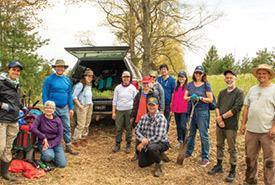
Volunteers tree planting, ON. (Photo by NCC)
Along with all of the property protected and money raised, the third measure of the Landmark Campaign’s success is the 110,000 donors — Canadians from all regions and walks of life and beyond — who came together to save the lands and waters that sustain us all. Perhaps even more impressive, two thirds of these donors were inspired to give for the first time, and nearly 100,000 gave under $1,000, emphasizing that every donation counts.
“NCC listened to Canadians and their vision for a better world, and turned it into a tangible goal that Canadians responded to,” says Kyria Knibb-McLuhan, senior director, campaign and development operations at NCC.
For two of those donors, Jan Oudenes and Isobel Ralston, Cockburn Island was their entry point into the campaign. In 2017, the Toronto-area couple sold a successful business and retired. Ardent paddlers and hikers, they then decided to commit the next chapter of their lives and their accumulated wealth to helping address climate change and biodiversity loss. To do that, they created MapleCross, a self-funded enterprise with a mission to protect Canada’s natural environment by supporting organizations that conserve ecologically sensitive land. “We started talking with NCC and they mentioned Cockburn Island,” says Ralston.
At the time, in early 2019, NCC was trying to raise funds to acquire an additional 586-hectare (1,450-acre) parcel to add to the 60 per cent of Cockburn Island already secured. Like most people, Jan and Isobel had never heard of it. But once they learned of the island’s ecological value and the protection and stewardship plan already in place, they funded the majority of the acquisition of what is now called the MapleCross Tract.
Since then, MapleCross has been the lead donor in the purchase of four more properties, totalling 1,463 hectares (3,614 acres), under the Landmark Campaign banner. Two of those are in Ontario, the others are in Quebec
and Saskatchewan.
“We asked NCC to come up with the proposals,” says Oudenes. “In essence, we asked them what their priority was in terms of their science.” Adds Ralston: “We want to invest in land conservation, not just in our backyard of Ontario, but across all of Canada. We just want to make an impact where we feel it is most needed. NCC provides that national scope.”
Every donation counts
While not every donor to the Landmark Campaign had the same means, motivation or directed outcome, Knibb-McLuhan notes that all played a similar role, directly or indirectly, in helping NCC deliver on the campaign’s three main themes: Conserve, Connect and Inspire. “Every gift made a difference.”
“Conserve was really all about the bread and butter of what we do every day, every week, every year,” Knibb-McLuhan says. “But the focus was on conserving more, doing it faster, doing it more efficiently and doing it better for the best conservation outcomes possible. And we certainly did that.”
Along with individual donors, other contributors to the Landmark Campaign included the federal government, provinces, corporations, family foundations, community groups and an array of other organizations. Most of the federal money was provided through the Natural Areas Conservation Program or its successor, the Natural Heritage Conservation Program. To activate those funds, NCC is required to raise matching contributions (1.5:1) from other donors.
“That’s part of what makes NCC’s role and abilities so unusual,” says Knibb-McLuhan. “We have the ability to bring together unique partners, whether it’s individuals and governments, or corporations and Indigenous communities, to make this important conservation work happen.”
Two widely different, but complementary, examples illustrate Knibb-McLuhan’s point. The first, from the Landmark Campaign’s early days, centres on a magnificent 12,357-hectare (30,535-acre) property owned and managed by the Waldron Grazing Co-operative Ltd. – made up of more than 50 ranchers in the southern foothills region of Alberta.
In 2013, NCC collaborated with the Waldron owners in crafting a conservation agreement (a legal agreement that puts restrictions on its use) to ensure the Waldron, its grasslands, streams and forests, would always remain intact. The agreement permits ongoing grazing by co-op shareholders but no other change of use. In 2015, the Waldron co-op bought an adjacent 1,700-hectare (4,200-acre) property, and an additional similar conservation agreement was established there in 2016.
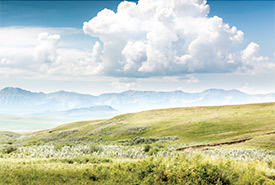
Waldron Ranch, AB (Photo by Kyle Marquardt)
The conserved property is the largest block of private land on the eastern slopes of the Rockies. Its securement assures the continuation of essential services like water filtration, carbon sequestration, soil protection, and forage for both domestic and wild animals. Other financial supporters, along with the Waldron Grazing Co-op, included the Alberta government, several local foundations, one Alberta-based corporation and a few local individuals.
The second example is equally innovative, and from a younger generation of nature lovers in Ontario. In late 2019 and early 2020, 49 Guelph-area Grade 12 students enrolled in the Upper Grand District School Board’s “Beyond Borders” business leadership program staged an annual charity gala, raising $109,000 to be distributed to four charities. They donated $25,000 to NCC’s Landmark Campaign.
The three other charities were linked to hospitals and health care, but according to Mike Parsons, the program’s founder and director, the students “felt strongly about supporting a charity that would align with the environment,” after studying sustainability and corporate responsibility in their program. “A couple of students found NCC and pitched it to the class as a great initiative that they’d like to support, and the class was immediately on board,” says Parsons. Once the COVID-19 pandemic has passed, he says he hopes students in subsequent years will continue to support NCC and get more involved in its work, perhaps by taking property tours or bringing in guest speakers.
Connecting to nature
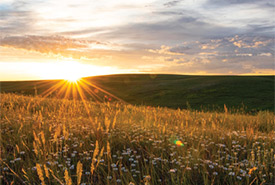
Buffalo Pound, SK (Photo by Jason Bantle)
According to Knibb-McLuhan, that same sentiment was at the heart of the Landmark Campaign’s second theme: Connect.
“Connect was all about connecting Canadians to nature, because when they connect to it and understand it, they appreciate it, and then they will factor it into their decision-making,” she says. “Certainly, the next generation of Canadians that we’re raising, who are going to be future leaders and future decision makers, we want them to be thinking about nature.”
To that end, during the Landmark Campaign, NCC continued to grow its hands-on volunteer program, in which volunteers spend time on NCC properties with the conservancy’s scientists, doing wildlife counts, property maintenance, habitat improvements and other activities. NCC also expanded its speaker series and, more recently, its online webinar programs. In all, Knibb-McLuhan says, more than 300,000 Canadians — including 18,000
hands-on volunteers — connected to nature through NCC’s various channels in the eight years of the campaign.
A connection with nature was one of the primary factors that motivated Jane Inch, who lives in Ottawa, to donate to NCC during the Landmark Campaign.
“Nature has always been really important for me,” says Inch. “It’s a place of solace as well as adventure and fun. I feel like I’ve gotten a lot from nature in my life, and yet I realize that there are threats to it. So, I’m grateful, at this stage, to be able to give back and support the nature that’s given me so much.”
Interestingly, even though she lives in Ontario, when Inch made the decision to make a donation to NCC, she contacted regional staff in Saskatchewan. “I’d heard about the decreasing number of greater sage-grouse in the grasslands of southern Saskatchewan, and that drew my attention. I also thought I’d like to focus on an area that might be overlooked by other Canadians. A lot of people see things about polar bears in the Arctic and we hear about whales on the coasts. The sage-grouse doesn’t get the press that those other, bigger animals do.” Several years after making that donation, Inch travelled to Saskatchewan to see the property she supported first-hand and learn more about the region. “NCC had programs locally. I was just going a very long distance to partake in one,” she says.
What she experienced, somewhat unexpectedly, was “feeling like I was joining in on a community of like-minded people,” she says. “Also, for me what was interesting was seeing the communities near these grassland ecosystems. I had never before been in a ranching community, or had discussions with Indigenous people from that region. There was so much more to the whole ecosystem than just the species. There were a lot of expanded horizons for me.”
Inspiring conservation
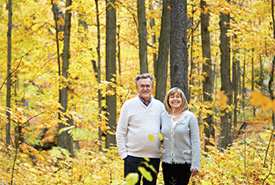
Jan Oudenes and Isobel Ralston (Photo by Mike Ford)
Inch’s account is also a testimonial to the Landmark Campaign’s third theme: Inspire. The theme applies to inspiring donors, the next generation of conservation leaders as well as the conservation sector as a whole, says Knibb-McLuhan. To address the next generation during the Landmark Campaign, NCC expanded its intern program from 30 placements a year to more than 90. “Some of them stay on, grow up within NCC and have great careers. Others go on to other organizations. It’s feeding the sector,” Knibb-McLuhan explains.
NCC donors further supported the sector through the campaign by assisting other Canadian land trusts with financial and staff resources, tools, knowledge and technology. The goal of inspiring others isn’t limited to NCC itself, however. Isobel Ralston and Jan Oudenes say one of their aims as major donors is to inspire other Canadians, through their example, to support conservation. “The dollars that flow into the protection of nature are still quite limited,” says Oudenes. “Part of what we want to do is to make it known, to inspire other people, and to make sure that the movement becomes much larger.” These aims underline one other important, final point.
Despite the successful efforts of its donors and supporters to complete the Landmark Campaign, and the resulting tremendous achievements, the work is not done. “We’ve made such great strides, but it’s going to take a lot more to get where we need to be — as a country and in the world,” says Knibb-McLuhan. “For example, Canada now has a commitment to conserve 30 per cent of our lands and waters by 2030. So, one of NCC’s long-term goals is supporting Canadian leadership in meeting our commitments around that.”
The reality, too, is that major habitat types are still in decline, and the dual threats that Ralston and Oudenes highlighted — climate change and biodiversity loss — still need more urgent attention.
And so, even as NCC marks the end of one campaign, work is underway on the organization’s next strategic plan. Knibb-McLuhan says that she and other members of the organization draw their own inspiration from the commitment they’ve seen from so many Canadians in supporting the Landmark Campaign over the past eight years.
“I think that awareness levels and the feeling of urgency are greater now than they ever have been before. The climate change conversation is so much more important to Canadians than ever before. We all realize that what we do here has a larger impact on humankind. All of those issues will be really big factors in NCC’s thinking going forward.”
This story originally appeared in the Winter 2021 issue of the Nature Conservancy of Canada Magazine. To learn more about how you can receive the magazine, click here.




